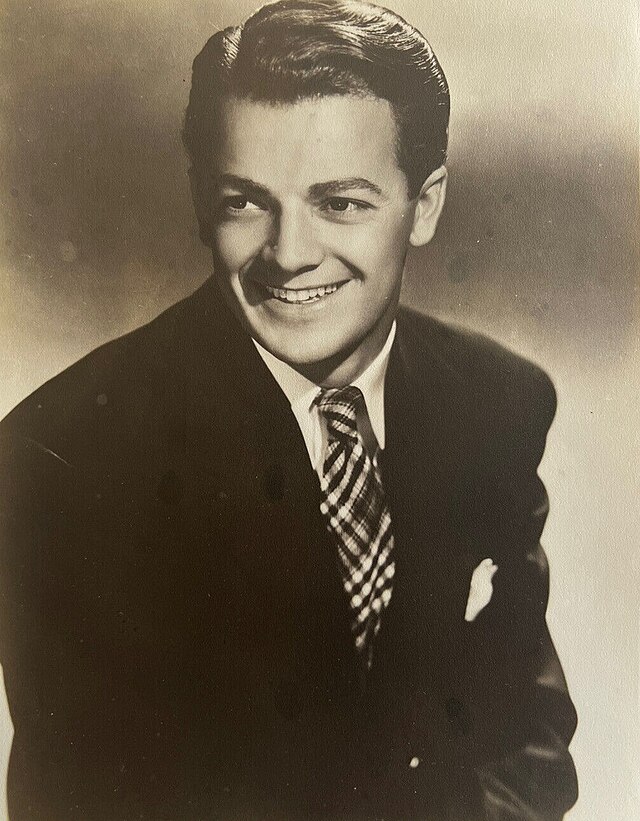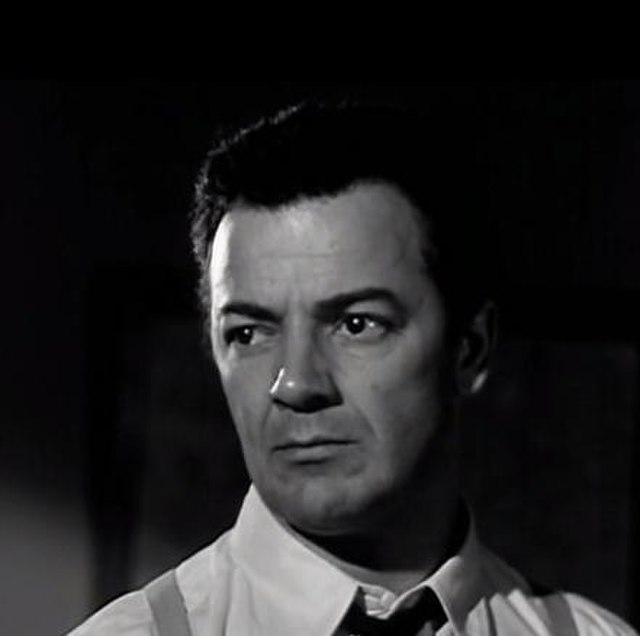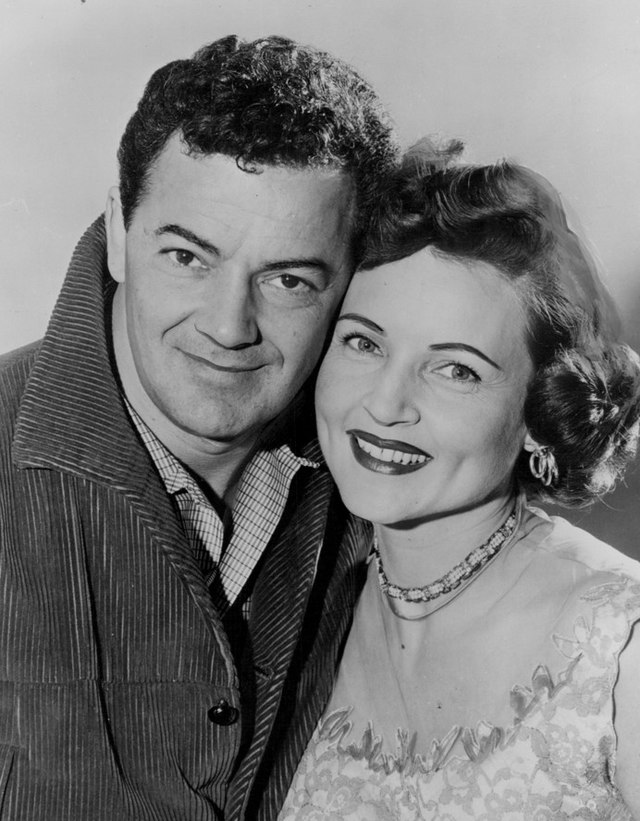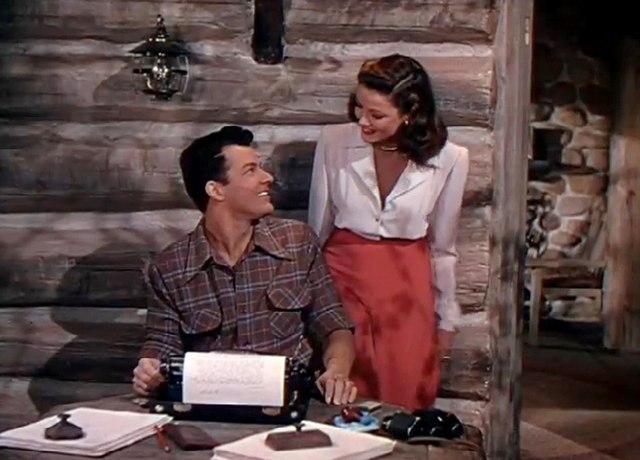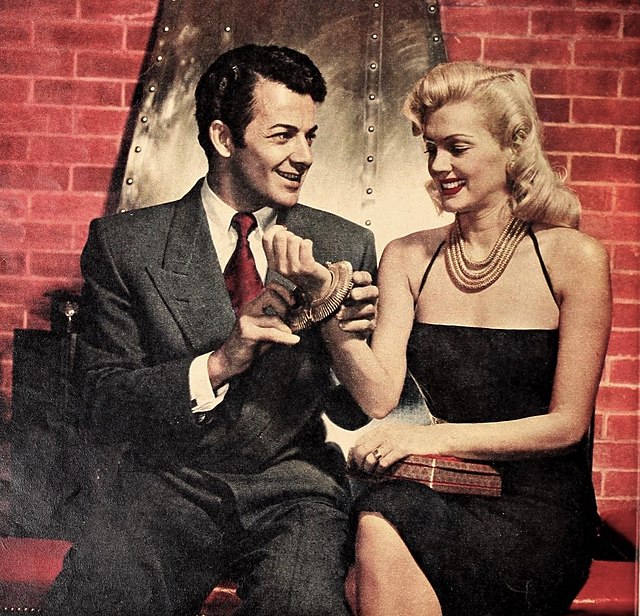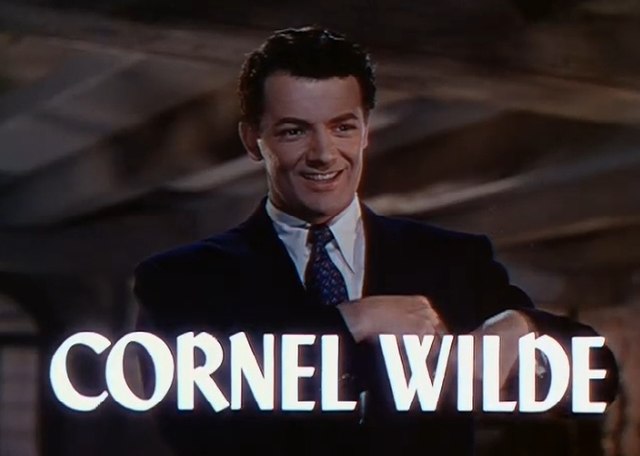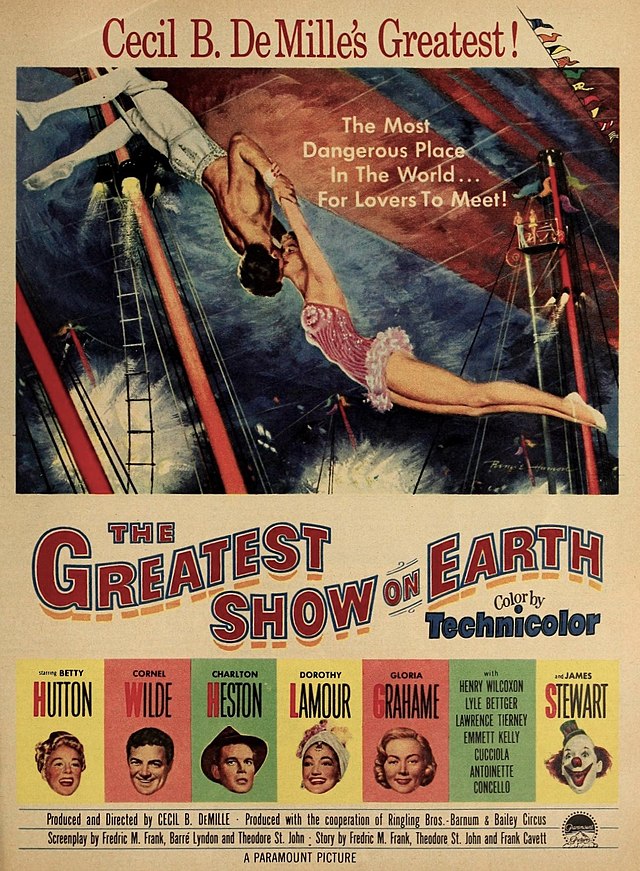Cornel Wilde
back| Full Name | Kornél Lajos Weisz |
| Stage Name | Cornel Wilde |
| Born | October 13, 1912 |
| Birthplace | Privigye, Hungary (now Prievidza, Slovakia) |
| Died | October 16, 1989 |
| Buried | Westwood Village Memorial Park Cemetery, Los Angeles, California |
| Married to | Patricia Knight (m. 1937–1951) - Jean Wallace (m. 1951–1981) |
| Children | One daughter with Patricia Knight: Wendy Wilde - One son with Jean Wallace: Cornel Wallace Wilde |
| Notable films | A Song to Remember (1945) - Leave Her to Heaven (1945) - The Big Combo (1955) - The Greatest Show on Earth (1952) - Road House (1948) |
Cornel Wilde
Hollywood’s Renaissance Leading Man
Wilde was a talented actor and filmmaker known for his athleticism and European charm. Initially interested in becoming a doctor, he left pre-med studies to pursue a career in acting, making a successful transition to Hollywood.
He became known for his performances in romantic, action, and noir films, and he later turned to directing, making a significant impact in Hollywood with his own productions.
Related
Cornel Wilde (1912 – 1989)
Biography and Movie Career
Cornel Wilde was born Kornél Lajos Weisz on October 13, 1912, in Privigye, Hungary (now Prievidza, Slovakia). He came from a Jewish family and moved with them to the United States when he was seven years old. His family settled in New York City, where Wilde quickly became immersed in American culture. Despite speaking no English when he first arrived, he was a quick learner and soon became fluent.
Wilde was not only intellectually gifted but also athletically talented. His early ambitions leaned toward the medical field, and he enrolled at Columbia University, where he studied pre-med. Along with his academic achievements, Wilde was a skilled fencer, a passion that would play a role in his career later on. In fact, he was so accomplished in fencing that he qualified for the U.S. Olympic fencing team in 1936, though he ultimately chose to pursue acting over competing in the Olympics.
Path Towards Success: From Broadway to Hollywood
Wilde's interest in the arts led him to abandon his medical studies in favor of a career on the stage. His first successes came on Broadway, where his good looks, athleticism, and European charm made him a sought-after actor in the theater world. He also worked as a fencing instructor for theatrical productions, using his expertise to train other actors. It was through his work on Broadway that Wilde eventually caught the attention of Hollywood producers.
He moved to Hollywood in the early 1940s and adopted the stage name Cornel Wilde, altering his original name to sound more appealing to American audiences. His breakthrough role came in 1945, when he starred as composer Frédéric Chopin in "A Song to Remember." Wilde’s portrayal earned him an Academy Award nomination for Best Actor, and from then on, he became a leading man in Hollywood.
Hollywood Stardom: Key Movies and Directorial Ambitions
Cornel Wilde's rise to stardom was marked by his versatility in a variety of film genres. He appeared in dramas, romantic films, action-adventure movies, and, most notably, film noir. Some of his most important roles include:
- "Leave Her to Heaven" (1945), in which Wilde starred opposite Gene Tierney in a dark, psychological romance. The film became a box-office hit.
- "The Greatest Show on Earth" (1952), a circus drama directed by Cecil B. DeMille, where Wilde played the daring trapeze artist known for his physicality.
- "The Big Combo" (1955), a classic film noir where Wilde played the tenacious and morally complex police lieutenant.
- "Road House" (1948), a film noir where Wilde co-starred with Richard Widmark and Ida Lupino, showing his continued success in the genre.
In the mid-1950s, Wilde grew frustrated with being typecast as a handsome leading man and decided to take more control over his career. He began directing and producing films. His most famous directorial effort came in 1965 with "The Naked Prey," a film he also starred in. The story of a safari guide being hunted through the African wilderness was a critical and commercial success, demonstrating Wilde's talent as a filmmaker.
Personal Life: Marriages and Relationships
Cornel Wilde’s personal life was marked by two significant marriages. His first marriage was to actress Patricia Knight in 1937. The couple had a daughter, Wendy Wilde, but their relationship deteriorated over time, and they divorced in 1951.
Shortly after his divorce, Wilde married actress Jean Wallace, with whom he had co-starred in several films, including "The Big Combo." They had a son, Cornel Wallace Wilde Jr. The couple remained married for three decades, but their marriage was reportedly tumultuous, with reports of infidelity and conflicts. They divorced in 1981.
Wilde's personal life was also intertwined with his professional ambitions. Both of his wives were actresses, and his collaborations with Jean Wallace were particularly noteworthy, with the two starring in and producing films together. Wallace herself struggled with mental health issues and addiction, which added strain to their marriage.
Passions: Fencing, Literature, and Filmmaking
Beyond acting, Cornel Wilde had a number of personal passions that influenced his life and career. His fencing skills were legendary in Hollywood, and he often did his own stunt work in films, including sword fights and physically demanding scenes. He was also an avid reader and had a deep appreciation for literature, philosophy, and history, which informed many of the projects he pursued as a filmmaker.
Wilde’s directorial work reflected his intellectual and adventurous spirit. "The Naked Prey" stands as a testament to his interest in survival stories and the human condition. The film, set in Africa and featuring minimal dialogue, was both a critical and commercial success and is considered a classic in the survival genre.
Final Years and Death
In the later years of his career, Cornel Wilde took on fewer acting roles and focused more on directing and producing films, though none achieved the same level of success as "The Naked Prey." As the Hollywood system evolved in the 1970s and '80s, Wilde’s brand of filmmaking became less popular, and he gradually faded from the spotlight.
Cornel Wilde passed away on October 16, 1989, just three days after his 77th birthday. The cause of death was leukemia, a disease he had battled for some time. He died in Los Angeles, California, and was laid to rest at Westwood Village Memorial Park Cemetery in Los Angeles. His death marked the end of a dynamic and varied career in Hollywood, where he had left an indelible mark as both a matinee idol and a respected filmmaker.
Legacy
Cornel Wilde’s legacy in Hollywood is multifaceted. He is remembered not only as a classic leading man of the 1940s and 1950s but also as a pioneering filmmaker with a unique vision. His willingness to take risks and his passion for storytelling, both as an actor and a director, earned him a lasting place in film history. "The Naked Prey," in particular, remains a significant achievement in the annals of adventure cinema, and Wilde’s contributions to the film noir genre continue to be appreciated by fans of classic Hollywood.
Cornel Wilde Video Bio
Physical Acting Style of Cornel Wilde
Cornel Wilde’s acting style was a unique blend of physicality, charm, and a subtle intensity that allowed him to transition smoothly between various genres throughout his career. Whether portraying a romantic lead, a swashbuckling hero, or a morally complex character in film noir, Wilde’s approach to acting remained grounded in several key characteristics that defined his on-screen presence.
Physicality and Athleticism
One of Wilde’s defining traits as an actor was his exceptional physicality. His background as a fencer and athlete lent him a natural grace and confidence in physically demanding roles. This athleticism was evident in many of his swashbuckling and adventure films, where he often performed his own stunts and action sequences. His ability to handle sword fights and intense action scenes with authenticity became a hallmark of his performances in films like "The Bandit of Sherwood Forest" (1946) and "The Greatest Show on Earth" (1952). Wilde’s physical prowess was also showcased in his directing debut, "The Naked Prey" (1965), where he played a safari guide hunted by tribesmen through the African wilderness. His body language and endurance communicated his character’s survival instinct in ways that dialogue could not.
Romantic Charm and Elegance
In the 1940s and 1950s, Wilde was often cast as a romantic lead, where his sophisticated charm and good looks made him an ideal choice for roles that required a combination of tenderness and masculinity. His European background contributed an air of elegance and mystery, which made him stand out from other actors of his time. In films like "Leave Her to Heaven" (1945) and "Forever Amber" (1947), Wilde portrayed romantic figures who were desirable yet emotionally complex. His performances in these films had a refined quality, where he conveyed passion and intensity without ever becoming overly theatrical or melodramatic.
Wilde had the ability to express depth and emotion with subtlety, particularly through his eyes and facial expressions. In romantic scenes, he often used a quiet intensity, allowing his characters’ feelings to unfold gradually. This restraint made his performances more believable, and his characters often felt grounded in reality, even in highly dramatic circumstances.
Understated Intensity
While many actors of Wilde’s era were known for their larger-than-life personas, Wilde’s style was often more subdued, marked by an understated intensity. This was particularly evident in his roles in film noir, where he played morally ambiguous characters with a quiet strength. In "The Big Combo" (1955), for instance, Wilde’s portrayal of Lieutenant Leonard Diamond, a relentless police officer, was filled with an internalized tension. He was able to convey obsession, frustration, and moral conflict with minimal dialogue, relying instead on body language and nuanced facial expressions. This made his characters feel more real and allowed audiences to connect with the emotional undercurrents driving his performances.
Wilde’s ability to suggest an internal struggle without being overtly expressive was a key factor in his success in noir films. His characters were often men who lived in morally gray areas, and Wilde's restrained approach reflected the uncertainty and ambiguity of the situations they faced. He never overacted but instead let the audience sense the underlying emotion, adding complexity to his roles.
Versatility Across Genres
Wilde’s acting style was adaptable, allowing him to transition between different genres with ease. His versatility was one of his greatest strengths as an actor. Whether starring in a historical epic, a romantic drama, or an action-adventure film, Wilde was able to tailor his approach to fit the tone and demands of the story. For instance, in romantic films like "A Song to Remember" (1945), Wilde’s portrayal of composer Frédéric Chopin required sensitivity and vulnerability, while in "California Conquest" (1952), he played a more rugged, adventurous figure driven by patriotic fervor. His ability to inhabit characters in such diverse genres speaks to his range as an actor.
Even in his directing work, Wilde showed his willingness to push boundaries and experiment with different styles, as seen in "The Naked Prey." Here, his acting became almost entirely physical, with minimal dialogue, relying on his expressions and body movements to communicate the character’s struggle for survival. This focus on visual storytelling highlighted Wilde's comfort in physically and emotionally intense roles, showing how he could use silence and movement to convey deep meaning.
Emotional Depth and Vulnerability
Though often cast as a strong, leading man, Wilde was able to bring a sense of vulnerability to his characters, which set him apart from more one-dimensional heroes of the time. In films like "Shockproof" (1949) and "Storm Fear" (1955) (which he also directed), Wilde portrayed men who were tough on the outside but internally conflicted and emotionally raw. In these performances, he allowed his characters’ emotional fragility to surface gradually, making them more relatable and complex. Wilde often took on roles that dealt with themes of guilt, redemption, and inner conflict, and he was able to communicate these deeper aspects without resorting to overacting.
His characters were frequently men grappling with personal demons or larger moral dilemmas, and Wilde’s subtle approach to these themes made his performances richer. He was able to express anguish, doubt, and fear in ways that were nuanced rather than exaggerated, making his characters feel more human and approachable.
Directing and Acting: A Symbiotic Relationship
As Wilde moved into directing, his acting style began to reflect his growing interest in visual storytelling. Films like "The Devil’s Hairpin" (1957) and "Beach Red" (1967), both directed by Wilde, displayed his keen sense of pacing and tension, which he applied to his own performances. Wilde’s experience behind the camera enhanced his acting, as he understood the importance of framing, timing, and the power of silence in film. In these projects, his performances became more introspective, and he seemed more attuned to the way his characters interacted with their environments and the broader narrative.
Wilde’s roles in the films he directed were often challenging, both physically and emotionally, and his dual role as actor and director gave him a deep understanding of the characters he portrayed. This allowed him to push his performances further, often experimenting with different approaches and styles that reflected his evolving perspective on filmmaking.
Quotes from Cornel Wilde
On Acting and Filmmaking:
- "You can’t be an actor for long without realizing that self-discipline is the key to success."
Wilde emphasized the importance of hard work and self-control in his career, a philosophy that guided his path both as an actor and a director.
- "I’ve always felt that one of the most demanding challenges for an actor is to communicate without dialogue."
This statement reflects his work in "The Naked Prey" (1965), where much of the film relied on physical expression and visual storytelling, demonstrating Wilde’s commitment to the craft beyond words.
- "You get out of a thing what you put into it. And I have always believed that you must put in everything you have."
This quote speaks to Wilde's dedication and intensity in all his professional endeavors, including directing, producing, and acting. He was known for his hands-on approach, especially when transitioning into filmmaking.
- "An actor has to reach deep into his own well of emotions to bring out the truth in the character he's portraying."
Wilde believed in the emotional depth required to portray authentic characters, which is evident in his more introspective roles, particularly in film noir.
On Hollywood and Stardom:
- "Hollywood is a place where they’ll pay you a thousand dollars for a kiss and fifty cents for your soul."
Wilde’s reflection on the superficial nature of Hollywood stardom reveals his understanding of the industry’s often materialistic and fleeting values. It’s a common sentiment among actors of his generation who felt disillusioned by the business side of the industry.
- "There’s more to being a star than just being a success in a string of movies. You have to contribute something lasting."
Wilde believed that lasting success in Hollywood came not just from fame but from making a meaningful contribution to the art of cinema. This philosophy likely influenced his decision to transition into directing and creating films with deeper narratives.
On Life and Work:
- "The biggest reward for a man’s toil is not what he gets for it, but what he becomes by it."
A thoughtful reflection on personal growth, Wilde believed that the journey and what it makes of a person are more important than material rewards or accolades.
- "If you love what you do, you'll never work a day in your life."
This quote highlights Wilde's passion for his craft. Despite the challenges he faced in his career, his love for acting and filmmaking was always evident.
- "In life, as in filmmaking, the hardest part is to keep going and not lose sight of your vision."
Wilde expressed his belief in perseverance, especially relevant in the often difficult journey of making films and sustaining a career in the entertainment industry.
On Directing:
- "Directing a film is like painting. You have a vision in your head, and it’s your job to transfer that onto the screen with precision, care, and emotion."
Wilde was an advocate for the director's role as the creator of a film's visual and emotional experience. His passion for the art of filmmaking, especially as seen in "The Naked Prey," shines through in this quote.
What Others said about Cornel Wilde
Cornel Wilde was admired for his versatility, physicality, and intelligence as an actor and filmmaker. His peers, critics, and collaborators often commented on his dedication, his unique blend of European sophistication and American grit, and his ability to transition from acting to directing successfully.
Co-stars and Collaborators:
Patricia Knight (first wife and co-star)
Patricia Knight, Wilde’s first wife and occasional co-star, once said:
- "Cornel was intense and serious about his work. He believed in giving everything to his craft, and that was something I always admired about him."
Patricia acknowledged Wilde’s unwavering dedication to his roles and his passion for acting. Although their marriage eventually ended, she held great respect for his work ethic.
Jean Wallace (second wife and frequent collaborator)
Jean Wallace, Wilde’s second wife and co-star in films such as "The Big Combo" and "Storm Fear," praised his talents both in front of and behind the camera:
- "He was a visionary when it came to directing. Cornel had a way of telling stories that was unique—he could make you feel something even in the quietest moments."
Jean spoke of his gift for visual storytelling and the emotional depth he brought to the characters he directed and portrayed.
Richard Widmark (co-star in "Road House")
- "Cornel was always prepared. He had an incredible work ethic and was someone you could rely on in every scene. He wasn’t flashy, but he had an inner fire that came through in his performances."
Widmark appreciated Wilde’s professionalism and intensity, particularly in their work on the film "Road House." He admired Wilde’s ability to communicate powerful emotions without overacting.
Critics and Industry Professionals:
Cecil B. DeMille (director of "The Greatest Show on Earth")
- "Cornel Wilde was an actor who brought both grace and danger to the screen. He was always willing to go the extra mile for a performance, especially in physically demanding roles."
DeMille, who directed Wilde in "The Greatest Show on Earth," praised his physicality and commitment to his craft. Wilde’s portrayal of a trapeze artist in the film required rigorous physical stunts, which DeMille admired.
Leonard Maltin (film critic and historian)
- "Wilde’s early career showcased his romantic, heroic side, but it’s in his later, more introspective roles, and certainly his directing work, that you really see what he was capable of. He was far more than just a leading man."
Maltin recognized Wilde's evolution from a conventional leading man in the 1940s to a more nuanced actor and director in later years, especially through films like "The Naked Prey."
Bosley Crowther (film critic for The New York Times)
- "In ‘A Song to Remember,’ Wilde’s portrayal of Chopin is both tender and passionate, a performance that allows him to transcend the typical constraints of the biopic genre. He shows great emotional range."
Crowther praised Wilde’s Oscar-nominated performance in "A Song to Remember," highlighting his ability to deliver a layered portrayal of the famous composer.
Peers in the Industry:
Charlton Heston (fellow actor and Hollywood contemporary)
- "Cornel Wilde was a man who took control of his own career at a time when that wasn’t easy in Hollywood. He was someone who cared deeply about the kind of stories he wanted to tell, both as an actor and a director."
Heston admired Wilde for his independence and determination to shape his career, particularly through his later work as a filmmaker.
Ida Lupino (co-star in "Road House")
- "Cornel was quiet but strong. He had a way of making every scene count without overshadowing his co-stars. You could always trust him to bring authenticity to his roles."
Lupino, who starred with Wilde in "Road House," noted his subtle yet powerful presence on-screen. She respected his ability to be a generous actor, ensuring that each scene felt balanced and authentic.
Robert Wise (director)
- "Cornel had a unique versatility as an actor—he could be the romantic lead, the action hero, and the conflicted man. He brought intelligence to his roles, which made them stand out."
Wise appreciated Wilde’s ability to navigate multiple genres with ease, always bringing depth and thoughtfulness to his performances.
Awards and Recognition
Cornel Wilde, though not the most highly awarded actor of his era, received recognition for his work in both acting and directing, particularly during the height of his career in the 1940s and 1960s.
Academy Award Nominations
- Best Actor Nomination for "A Song to Remember" (1945)
Wilde received an Academy Award nomination for Best Actor for his portrayal of the Polish composer Frédéric Chopin in this biographical drama. This role marked his breakthrough in Hollywood, with critics and audiences praising his sensitive and emotionally resonant performance. Although Wilde didn’t win, this nomination cemented his status as a leading man in Hollywood during the 1940s.
Golden Globe Awards
- Golden Globe Nominee for "Leave Her to Heaven" (1945)
Though Wilde did not personally receive a nomination, the film itself was well-received by critics and earned several nominations. His performance in the film, as writer Richard Harland, opposite Gene Tierney, garnered him critical praise. Gene Tierney was nominated for Best Actress, and Wilde’s involvement in such a highly recognized film reflected well on his stature as a leading man.
Directorial Recognition: "The Naked Prey" (1965)
- Academy Award Nomination for Best Story and Screenplay Written Directly for the Screen (1967)
While Wilde did not receive a personal nomination for his acting or direction, "The Naked Prey" received an Academy Award nomination for Best Original Story and Screenplay. The film, which Wilde directed and starred in, was a critical success, especially for its innovative approach to storytelling and its exploration of human survival. Wilde’s direction in the film was praised, and the movie is often cited as his greatest achievement as a filmmaker. - National Board of Review (1966)
"The Naked Prey" was also recognized by the National Board of Review as one of the top ten films of 1966. This accolade contributed to Wilde's reputation as a director who could create thought-provoking and visually striking films.
Venice Film Festival
- Venice Film Festival - Silver Lion Nominee for "Beach Red" (1967)
Wilde directed and starred in "Beach Red," a World War II drama that took a raw and realistic look at the psychological and physical toll of war. The film earned critical recognition and was nominated for the Silver Lion at the prestigious Venice Film Festival in 1967. While it did not win, the nomination was a significant achievement for Wilde, showing his directorial work was taken seriously on an international stage.
Hollywood Walk of Fame
- Star on the Hollywood Walk of Fame (1960)
Cornel Wilde was honored with a star on the Hollywood Walk of Fame on February 8, 1960, recognizing his contributions to the entertainment industry as an actor. The star is located at 1635 Vine Street in Hollywood, marking his lasting impact on the film world. This accolade is a significant recognition for any performer in Hollywood, signifying Wilde’s place among the greats of his generation.
Other Recognitions
- Recognition in Film Noir Genre
Wilde’s work in film noir, particularly in films like "The Big Combo" (1955) and "Road House" (1948), earned him critical acclaim within this genre. While he did not receive formal awards for these roles, his performances in noir are often cited as some of the most memorable of his career. "The Big Combo" is now regarded as a classic of the genre, and Wilde’s portrayal of the obsessive police lieutenant has been recognized by film historians and critics alike.
- Legacy in Adventure and Survival Films
Wilde’s work in survival and adventure films, particularly his direction and performance in "The Naked Prey," continues to be highly regarded in film circles. Though not widely recognized with awards at the time of release, the film has gained a cult following and remains influential for its unique visual storytelling and minimalist approach.
Summary of Major Awards and Recognition:
- Academy Award Nomination for Best Actor for "A Song to Remember" (1945)
- Academy Award Nomination for Best Story and Screenplay for "The Naked Prey" (1965)
- Golden Globe recognition for "Leave Her to Heaven" (1945)
- Venice Film Festival Silver Lion Nomination for "Beach Red" (1967)
- Hollywood Walk of Fame Star (1960)
- National Board of Review Top Ten Film recognition for "The Naked Prey" (1966)
Movies with Cornel Wilde
1940s
- "High Sierra" (1941) – Though Wilde had an uncredited role, this film noir starred Humphrey Bogart as a hardened criminal on the run. Wilde appeared in a minor part as a reporter.
- "Knockout" (1941) – A boxing drama about a fighter whose rise to fame is complicated by his manager’s dishonest tactics. Wilde had a supporting role as an opponent of the main boxer.
- "Life Begins at Eight-Thirty" (1942) – Wilde played Robert Carter, a young man who tries to help a former stage star regain his career. The film explores the complexities of relationships and ambitions.
- "Wintertime" (1943) – A musical comedy set in a winter resort, where Wilde portrayed Brad Barton, a wealthy playboy who finds romance and adventure amidst musical performances.
- "A Song to Remember" (1945) – Wilde’s breakthrough role as the famous composer Frédéric Chopin. This biographical drama centers on Chopin’s career, his battle with tuberculosis, and his romance with writer George Sand. Wilde was nominated for an Academy Award for Best Actor.
- "Leave Her to Heaven" (1945) – A psychological thriller in which Wilde played writer Richard Harland, who marries a beautiful woman, only to discover her obsessive jealousy that leads to tragic consequences.
- "The Bandit of Sherwood Forest" (1946) – Wilde starred as Robert of Nottingham, the son of Robin Hood. The film focuses on his mission to stop a tyrant from seizing the throne and follows in the swashbuckling tradition of adventure films.
- "The Homestretch" (1947) – A romantic drama set in the world of horse racing, Wilde played a successful horse breeder who becomes entangled in a love triangle with Maureen O'Hara's character.
- "Forever Amber" (1947) – Wilde played Bruce Carlton, a nobleman who has a love affair with Amber St. Clare, an ambitious woman determined to rise in English society. The film was based on the popular novel by Kathleen Winsor.
- "Road House" (1948) – A film noir where Wilde portrayed Pete Morgan, the friend of a nightclub owner. Things spiral out of control when a beautiful singer causes jealousy and violence between the two men.
- "The Walls of Jericho" (1948) – Set in a small town, Wilde played a lawyer involved in political corruption and complicated romantic entanglements. The film focuses on moral struggles and social conventions.
- "Shockproof" (1949) – In this crime drama, Wilde played Griff Marat, a parole officer who falls in love with his parolee, a beautiful woman with a dangerous past, leading them both into criminal trouble.
1950s
- "The Greatest Show on Earth" (1952) – Directed by Cecil B. DeMille, Wilde played a trapeze artist competing for the affection of the circus owner, set against the backdrop of the dramatic lives of circus performers.
- "California Conquest" (1952) – Wilde starred as Don Arturo Bordega, a Spanish Californian fighting for California's independence from Mexican rule. The film is a mix of historical drama and action.
- "Treasure of the Golden Condor" (1953) – A historical adventure film, where Wilde portrayed Jean-Paul, a Frenchman who sets off on a quest to claim his family’s lost fortune, enduring many challenges in the process.
- "Saadia" (1953) – Set in North Africa, Wilde played a French doctor who becomes involved in the local customs and superstitions of a tribe when he falls in love with a beautiful woman named Saadia.
- "Storm Fear" (1955) – In this film noir, Wilde portrayed a criminal on the run who takes refuge in his brother’s home, creating tension and conflict between family members. Wilde also directed this film.
- "The Big Combo" (1955) – A classic film noir, Wilde played Lt. Leonard Diamond, a relentless cop determined to bring down a crime boss, facing danger, corruption, and betrayal.
- "The Scarlet Coat" (1955) – Set during the American Revolution, Wilde portrayed Major John Bolton, a spy who becomes involved in the notorious case of Benedict Arnold's betrayal.
- "Beyond Mombasa" (1956) – A jungle adventure film, Wilde played Matt Campbell, who travels to Africa to investigate his brother’s death and uncovers a cult practicing human sacrifices.
- "Hot Blood" (1956) – Wilde played a gypsy who is tricked into an arranged marriage in this musical drama. The film explores gypsy culture and romantic entanglements.
- "The Devil's Hairpin" (1957) – A racing drama directed by Wilde, in which he also starred as a racing driver who must face his demons and change his arrogant ways to win back his former love and his career.
- "Edge of Eternity" (1959) – A Western-style crime drama where Wilde played a sheriff investigating mysterious murders in the Grand Canyon. The film combined elements of suspense and adventure.
1960s
- "Maracaibo" (1958) – Set in Venezuela, Wilde played an oil firefighter tasked with putting out fires in dangerous oil fields, all while dealing with personal drama and intrigue. Wilde also directed the film.
- "The Fifth Musketeer" (1963) – Wilde had a supporting role in this historical swashbuckler based on Alexandre Dumas’s "The Man in the Iron Mask."
- "The Naked Prey" (1965) – Perhaps Wilde’s most famous directorial effort, where he also starred as a safari guide pursued by native tribesmen in Africa. The film is known for its intense survival storyline and minimal dialogue.
1970s
- "Beach Red" (1967) – Directed by and starring Wilde, this World War II drama depicted a brutal battle between American Marines and Japanese soldiers on a Pacific island, focusing on the psychological toll of war.
- "Sharks' Treasure" (1975) – A maritime adventure film in which Wilde, playing a treasure hunter, leads a group searching for a sunken fortune, but they face challenges from both nature and ruthless criminals.
1980s
- "Garrett" (1971) – Wilde took a lesser role in this TV movie set in the Old West, playing an older gunslinger.
- "Love Me Deadly" (1972) – In this low-budget horror-thriller, Wilde played a minor supporting role in a story about a necrophiliac cult.

